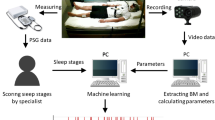Abstract
The closed eyes motion strongly depends on the sleep depth of humans. Typically, the electroencephalogram and motion of ciliary muscle’s measurement are common methods of evaluating the sleep status and eyeball motion respectively. The proposed survey is to make a wireless eye-mask for monitoring the closed eye motion non-invasively. The mask with CCD unit, wireless module, and an antenna can send the image of closed eye motion into the image-processing module in PC host. The spatial and frequency features from the eye-mask are analyzed to quantitatively describe relative position, velocity, and moving direction of eyelids and eyeballs. Besides, the motion history can feed into the support vector machine neural network and statistics units to evaluate the appropriate time to trigger the alarm if emergency occurs. The survey not only constructs a system with wireless monitoring the closed eye motion non-invasively but develops an algorithm judging whether the closed eye moving or not.







Similar content being viewed by others
References
Alwan M, Dalal S, Mack D et al (2006) Impact of monitoring technology in assisted living: outcome pilot. IEEE T Inf Technol B 10:192–198
Ancoli-Israel S, Ayalon L (2006) Diagnosis and treatment of sleep disorders in older adults. Am J Geriat Psychiat 14:95–103
Anliker U, Ward JA, Lukowicz P et al (2004) AMON: a wearable multiparameter medical monitoring and alert system. IEEE T Inf Technol B 8:425–427
Ashit T, John_Michael M, Steve M et al (2005) Eye-tracking architecture for biometrics and remote monitoring. Appl Optics 44:693–700
Becker PM, Jamieson AO (1992) Common sleep disorders in the elderly: diagnosis and treatment. Geriatrics 47:41–52
Carlson NR (2003) Physiology of behavior, 8th edn. Allyn and Bacon
Chen QR, Cham WK, Tsui HT (2002) A method for estimation and accurately extracting the eyebrow in human face image. Proc IEEE 2002 Conf 3:793–796
Choi SJ, Jiang ZW (2006) A novel wearable sensor device with conductive fabric and PVDF film for monitoring cardiorespiratory signals. Sensor Actuat A-phys 128:317–326
Endeshaw YW, Johnson TM, Kutner MH et al (2004) Sleep-disordered breathing and nocturia in older adults. J Am Geriatr Soc 52:957–960
Frank MG, Issa NP, Stryker MP (2001) Sleep enhances plasticity in the developing visual cortex. Neuron 30:1–20
Haykin S (1999) Neural networks, 2nd edn. Prentice Hall
Hsieh CW, Kan CW, Jong TL, Chen TL (2005) The motion analysis of closed eyes using support vector machine neural network. Twelfth international conference on biomedical engineering (ICBME 2005), Singapore, 2B2–11
Ingre M, Akerstedt T, Peters B et al (2006) Subjective sleepiness, simulated driving performance and blink duration: examining individual differences. J Sleep Res 15: 47–53
Jabobs JM, Cohen A, Hammerman-Rozenberg R et al (2006) Global sleep satisfaction of older people: the Jerusalem cohort study. J Am Geriatr Soc 54:325–329
Porat M, Zeevi YY (1988) The generalized Gabor scheme of image representation in biological and machine vision. IEEE PAMI 10(4):452–468
Press WH Teukoisky SA Vertterling et al (1993) Numerical recipes in C: the art of scientific computing. 2nd edn. Cambridge University Press, Cambridge
Richards KC, Beck C, O’Sullivan PS et al (2005) Effect of individualized social activity on sleep in nursing home residents with dementia. J Am Geriatr Soc 53:1510–1517
Roy T, Debreuve E, Barlaud M et al (2006) Segmentation of a vector field: dominant parameter and shape optimization. J Math Imaging Vis 24:259–276
Spenko M, Yu H, Dubowsky S (2006) Robotic personal aids for mobility and monitoring for the elderly. IEEE Trans Neural Syst Rehabil Eng 14(3):344–351
Wang HG, Sung E (2001) Gaze determination via images of irises. Image Vis Comput 19:891–911
Wang Y, Ostermann J, Zhang YQ (2001) Video processing and communication. Prentice Hall
Yoon IY, Kripke DF, Elliott JA et al (2003) Age-related changes of circadian rhythms and sleep–wake cycles. J Am Geriatr Soc 51:1085–1091
Author information
Authors and Affiliations
Corresponding author
Rights and permissions
About this article
Cite this article
Hsieh, CW., Kan, CW. & Jong, TL. Analysis of closed eyes motion using a wireless eye-mask. Med Bio Eng Comput 45, 365–374 (2007). https://doi.org/10.1007/s11517-007-0161-6
Received:
Accepted:
Published:
Issue Date:
DOI: https://doi.org/10.1007/s11517-007-0161-6




